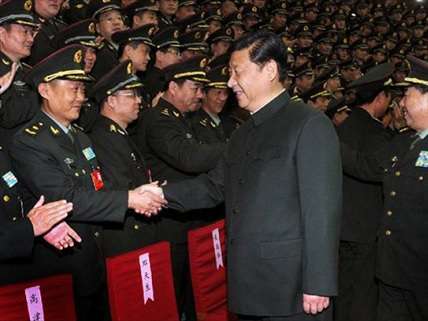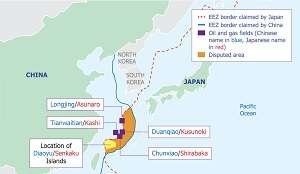Chinese Military at Heart of Asia Pivot Policy "rotten to the core"?
Xi Jinping needs the People's Liberation Army as a domestic political tool

Xi Jinping became General Secretary of the Chinese Communist Party the same day he became the chairman of the Central Military Commission, John Gernault points out in a piece in the May/June "Power" issue of Foreign Policy that shows a different side of the Chinese military than the one used to explain America's own military "Asia pivot." First the prevailing perception:
[The U.S. Pacific Fleet's chief intelligence officer James Fanell] spelled out in rare detail the reasons the United States is shifting 60 percent of its naval assets -- including its most advanced capabilities -- to the Pacific. He was blunt: The Chinese People's Liberation Army (PLA) Navy is focused on war, and it is expanding into the "blue waters" explicitly to counter the U.S. Pacific Fleet. "I can tell you, as the fleet intelligence officer, the PLA Navy is going to sea to learn how to do naval warfare," he said [in a conference]. "My assessment is the PLA Navy has become a very capable fighting force."
Xi is not so sure, and he needs the PLA to consolidate power at home. Gernault writes:
Despite the hype, however, high-ranking insiders have come forward to say the Chinese military is rotten to the core. Formal hierarchies are trumped by personal patronage, coordination between branches is minimal, and corruption is so pervasive that senior positions are sold to the highest bidders while weapons funding is siphoned into private pockets. "Corruption has become extremely institutionalized and significant," says Tai Ming Cheung, director of the Institute on Global Conflict and Cooperation at the University of California/San Diego. "It makes it much more difficult to develop, produce, and field the weapons systems required to achieve world-class power projection."
It's not just corruption. More than three decades of peace, a booming economy, and an opaque administrative system have taken their toll as well, not to mention that the PLA is one of the world's largest bureaucracies -- and behaves accordingly.
In communist China, there's a dual command structure, a military hierarchy subordinate to a parallel party one. After all, as Gernault writes, the PLA was formed as a tool of the Communist party that started fighting in China in 1927 and didn't stop till Korea more than two decades later. As a veteran of the party side of the PLA, the new Chinese president intends to use the army that way. Gernault relates:
At the same time, another top-level document emerged: a speech delivered in December by Xi himself, in which he gave thundering confirmation that the PLA's primary function is to defend the regime, not China. This was the lesson learned from the Soviet Union's collapse, he said. "In the Soviet Union, where the military was depoliticized, separated from the party, and nationalized, the party was disarmed," Xi warned, according to an extract of his speech that was published by journalist Gao Yu and broadly corroborated by other sources. "A few people tried to save the Soviet Union; they seized Gorbachev, but within days it was turned around again because they didn't have the instruments to exert power." Nobody in the vast Soviet Communist Party, Xi averred, "was man enough to stand up and resist."

The confrontation with Japan over the uninhabited but potentially resource rich Senkaku/Diaoyu Islands [marked yellow on map right] was an opportunity for Xi to fan nationalist fervor but also, as Gernault relates from a family friend of Xi's, a chance to "to sort the horses from the mules" by "walk[ing] them around the yard." What it looked like:
For the remaining three months of 2012, roughly once each day, a Chinese government plane flew southeast toward the Japanese-administered islands. With equal regularity, when the plane crossed an "identification" line nearly 100 miles east of the Chinese mainland, Japan tried and failed to make radio contact and then scrambled F-15 Eagle fighters from its Air Self-Defense Force. The Chinese planes would each veer east at about the 28th parallel and then north, out of harm's way, without crossing into Japanese-controlled airspace or encountering approaching Japanese fighters, according to Western defense officials. That's the way it happened on 91 occasions between October and December, according to Japan's Defense Ministry.
But on Dec. 13, the 75th anniversary of the Nanjing massacre and a day after Chinese media reported that Xi had called for "real combat" awareness during a three-day tour of a PLA warship and live-fire tank drills, a low-flying China Marine Surveillance Y-12 twin-propeller plane crossed the 28th parallel. It kept flying southeast and penetrated Japanese airspace -- the first such episode since Japan began monitoring half a century ago -- and took a snapshot of the largest of the disputed islands out of its left window, a photo that was published widely in the Chinese state media the following day.
But being ready for war means something else for Xi too:
What if the recent drums of war are a sign of China's weakness and not its impressive new strength? "When Xi tells his troops to be ready for war, it's really an admission that they're in disarray," says the [NATO country] defense attaché [in Beijing]. "He's saying, 'You guys are drunk, fat, and happy, siphoning off all the money into private accounts, and you need to get real.'"
And into this America "pivots." Read the rest of the article here, and watch Gernault explain to the Chinese state-owned Xinhua news agency how he cultivates sources in China (of which there are several in the article) here.


Show Comments (47)